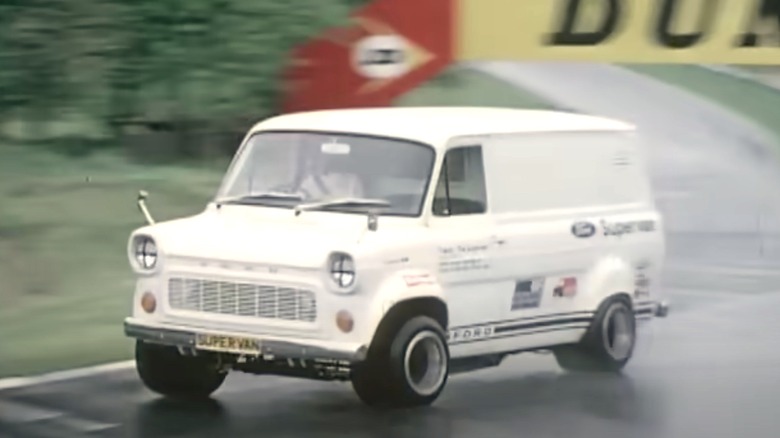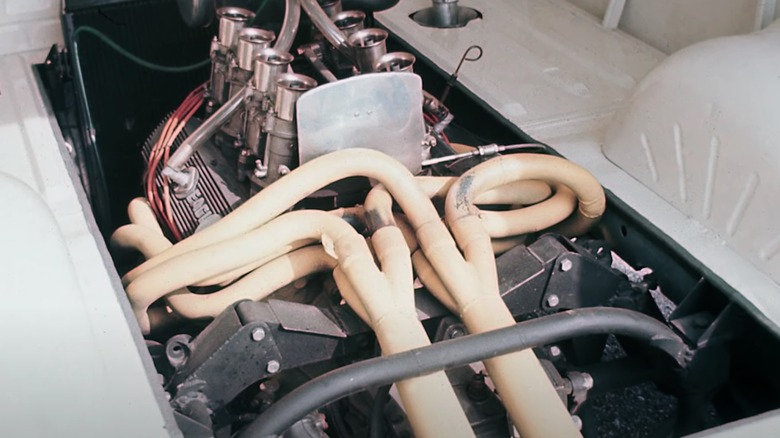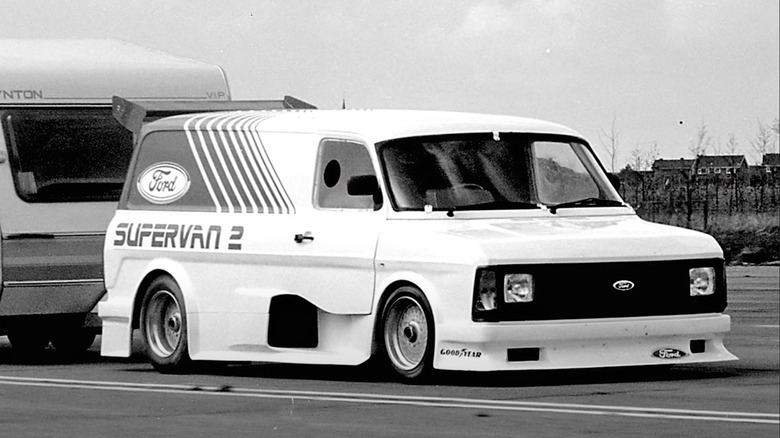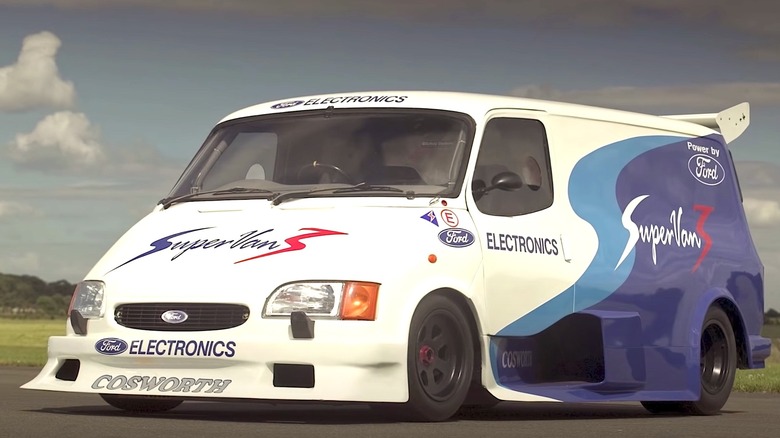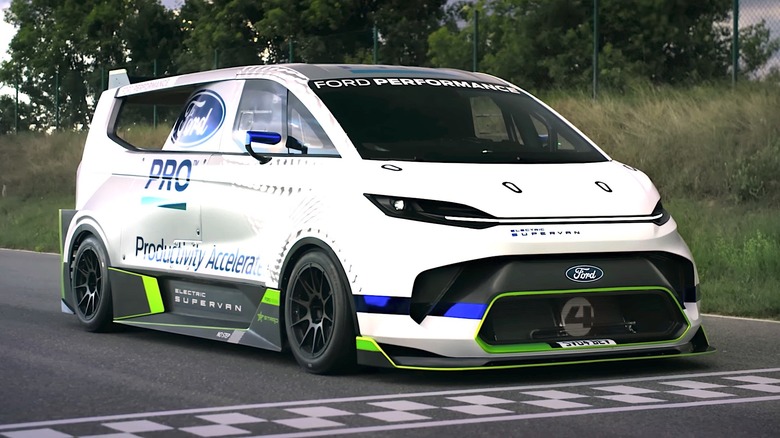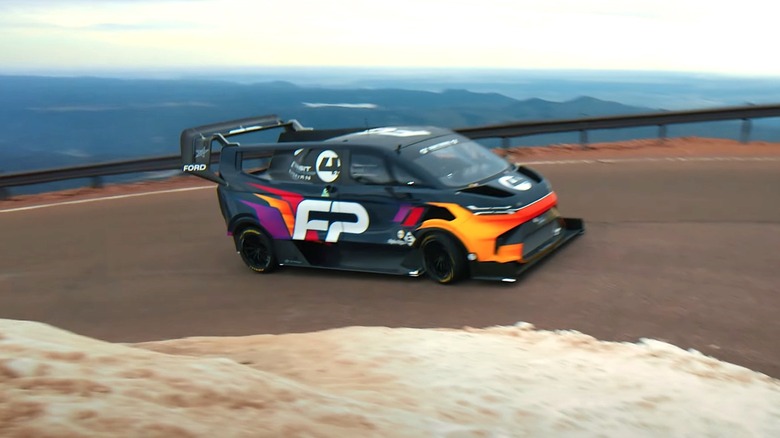Powerful People Mover: The History Behind Ford's Supervan
Since its introduction to the North American market in 2013, the Ford Transit has been the go-to vehicle for anyone needing a rock-steady light commercial vehicle. But that's been the case in Europe for nearly six decades. The first generation Transit debuted in the United Kingdom in 1965 and quickly became one of the country's best-selling vehicles. While the van has endured several re-designs over the years, few were quite as radical as the 1971 model dubbed the "Supervan."
Designed in large part to help raise the profile of the Transit across Europe, the Ford Supervan was essentially a full-blown race car packed inside the frame of the fabled cargo van. Once on the promotional trial, the kitschy but genuinely impressive Supervan took the automotive world by storm as gearheads and race fans marveled at its on-track capabilities. While the Supervan was never available on the commercial market, it remains a highlight among Ford's many innovations from the era. Like Ford's Transit, the Supervan has also seen its share of overhauls over the years. Here's a brief history of the famed Ford Supervan and its many descendants.
The O.G. Ford Supervan was packing some serious muscle
The Ford Transit's ascent to becoming Europe's premiere lightweight cargo vehicle was no doubt hastened due to its practicality, with its smaller-scaled frame and powerful engine making it ideal for trucking heavy loads through the tight confines of European cities. But it's safe to say practicality was not part of the equation when Ford decided to build their first Supervan. Frankly, there wasn't much Transit left when Ford gave it the ole Supervan overhaul.
When the design team was done with the Supervan, the only proper Transit element that remained was the van's iconic steel frame. That boxy frame almost hilariously housed the machinations of Ford's legendary GT40 race car, complete with a V8 engine (housed in the rear cargo hold) and custom Gurney-Weslake cylinder heads. That is the very same setup that famously helped Ford run circles around the competition (primarily Ferrari) at the legendary 1966 24 Hours of LeMans race. As reported by MotorTrend, the 435 hp engine gave the Supervan the capability of going 0-60 in seven seconds flat, with top speeds maxing out just north of 150 mph.
If you've never seen the original Supervan in action, know it's a legit sight to behold. And it was only the beginning of Ford's Supervan insanity.
The Supervan 2 got a seriously sleek re-design
The first iteration of the Ford Supervan continued to delight motorsport fans via race appearances throughout the 1970s. But in 1978, the high-octane version of the Transit van was made obsolete when Ford debuted the re-designed Transit Mark II. Ford's GT40 was also no longer the gold standard of racing, leaving Ford little choice but to give their Supervan a ground-up rebuild.
Thankfully, the Ford team was up to the challenge, debuting the dramatically upgraded Supervan 2 in 1984. The team did take a few more liberties with the Ford Transit body this go-round, eschewing the standard steel frame in favor of fiberglass and going with an aerodynamic, race-friendly body design fit with massive air intakes. That frame was fit over a Ford C100 Group C racing car chassis with a Cosworth DFL V-8 engine providing some serious power under the hood.
Given the significant upgrades, you'd be right in assuming the Supervan 2 outpaced its predecessor in virtually every arena. The vehicle's 0-60 mph time went from seven seconds to an impressive three, with top speeds jumping from 150 to 185 mph or more. It was also easier on the eyes than its predecessor, though some may argue it was the last Supervan that still looked like a van.
The super fast Supervan 3 didn't look much like a Ford Transit
The Supervan 2's reign lasted almost a decade, with Ford opting not to upgrade their experimental take on the Transit van until 1994. With the Transit selling well, the van didn't need much promotion by the time Supervan 3 hit the scene in the mid-90s, so one has to admire the fortitude Ford bosses displayed by continuing to finance the pricey Supervan project. And yes, they turned the heads of the racing world again when Supervan 3 hit the scene.
The Ford Transit had, of course, gotten another facelift by the time the Supervan 3 made its debut. The Ford team took a similar approach as its predecessor in designing the new racing van's body, championing a more track-ready aerodynamic frame for Supervan 3 than the Transit Mark III's allowed. Though the third generation Supervan retained the C100 chassis, it got a massive upgrade in the engine department, with the design team outfitting the vehicle with an old Formula 1 racing engine.
During that era, the 650bhp Cosworth HB V8 was more frequently used by the upper-echelon F1 racing teams. While the engine likely couldn't help the speedy Ford van keep pace with many F1 racing outfits, the upgrade made Supervan 3 the fastest Supervan to date.
The Supervan 4 brought the vehicle into the electric age
It would be almost thirty years before Ford Motor Company would set about conjuring a modern version of the Supervan. And if one were to do a side-by-side comparison of the 2022 Ford Transit and Supervan 4, you'd see the two vehicles don't have much in common. In fact, with its composite panels and sleek steel frame, the Supervan 4 looks more like an actual race car than the practical, lightweight cargo van that inspired it — even if Ford claims its body is based on the best-selling E-Transit Custom.
The E in that name indeed means the E-Transit runs on electricity. Seizing on the marketing potential, Supervan 4 is also powered solely by electricity. That fact makes its status as a full-blown speedster all the more impressive. According to Hagerty, four electric motors power Supervan 4, providing a whopping 1973bhp. The vehicle can reportedly go 0-60 in under two seconds. And if the promo video for the all-electric Supervan is accurate, it can reach a top speed of 320 mph.
Supervan 4 also boasts a high-tech on-dash Sync display that provides real-time driving data and easy transitioning between multiple drive modes. And if reports are accurate, Supervan 4's super-sleek re-design still leaves room for storage in the rear cargo space.
The upgraded Supervan 4.2 became a record breaking success
Not willing to rest on their proverbial laurels, the Ford design team has already given Supervan 4 an upgrade. While the all-electric Supervan 4.2 is far from a complete re-design, the upgraded version boasts some innovative improvements to the racing van's aerodynamics, which they deemed necessary ahead of its competing in the 2023 Pike's Peak International Hill Climb. Fitting the 4.2 with a carbon fiber front air splitter and a double-decker rear wing helped create the necessary downforce to help the Supervan 4.2 navigate the ever-winding, 156-turn course. It also contributed to the latest Supervan setting a new open-class track record.
Aerodynamics were not the only changes made on the Supervan 4.2. While its predecessor uses four motors to achieve its high speeds, the 4.2 requires only three, and that move means the vehicle isn't quite as powerful, topping out at about 1400 hp. The 4.2 also boasts carbon-ceramic front rotors, a plexiglass windshield, and a bare-bones interior with just a single seat for the driver. Those changes were made primarily so the vehicle would perform at maximum efficiency during its dramatic climb up the Pike's Peak course. Given how Supervan 4.2 performed during its run, it's safe to say they worked.
